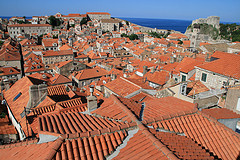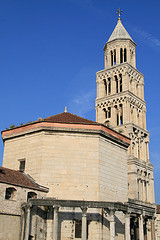Dubrovnik: Pearl of the Adriatic
Tuesday, June 8th, 2010I think I probably heard of Dubrovnik for the first time in late 2001 as I sat in the Feltrinelli international bookstore in Rome and began reading guidebooks to places I’d never considered visiting before. Ever since then I’ve been desperate to visit what is regularly described as the finest walled medieval city in the world. Finally, I got my chance.
 Leaving the rain of Bosnia & Hercegovina behind (I’d been absolutely soaked walking from the bus station to the old town of Mostar the day before, an episode from which my shoes still haven’t recovered), I arrived in Dubrovnik at lunchtime on Friday. What I found was a glorious, stunningly beautiful, almost perfect old town inside the famous walls, one that I roamed around with great pleasure for the next three days. It’s dreadfully touristy, of course, especially when the enormous cruise liners dump passengers by their hundreds into the harbour and they descend en masse into the city, but it comes with the territory, I suppose.
Leaving the rain of Bosnia & Hercegovina behind (I’d been absolutely soaked walking from the bus station to the old town of Mostar the day before, an episode from which my shoes still haven’t recovered), I arrived in Dubrovnik at lunchtime on Friday. What I found was a glorious, stunningly beautiful, almost perfect old town inside the famous walls, one that I roamed around with great pleasure for the next three days. It’s dreadfully touristy, of course, especially when the enormous cruise liners dump passengers by their hundreds into the harbour and they descend en masse into the city, but it comes with the territory, I suppose.
I stayed in a lovely little studio apartment in the heart of the old city and my strategy to beat the crowds was to rise before 7am when everyone else was sleeping and have the old town virtually to myself in the early morning, then read my book and watch the French Open on TV during the middle of the day before embarking on another walking session in the late afternoon – and I found that this worked pretty well.
 The highlight, of course, was a walk on top of the city walls, which I did as soon as they opened at 8am on Sunday morning and which I, entering at the eastern end and not the western end, had pretty much to myself for the next hour. From the walls you get an amazing panorama of the old city and the Adriatic Sea beyond, and I found it especially interesting to see which buildings had new orange tiles installed on their rooftops after the city was shelled in 1991, and which buildings were lucky enough not to have been hit.
The highlight, of course, was a walk on top of the city walls, which I did as soon as they opened at 8am on Sunday morning and which I, entering at the eastern end and not the western end, had pretty much to myself for the next hour. From the walls you get an amazing panorama of the old city and the Adriatic Sea beyond, and I found it especially interesting to see which buildings had new orange tiles installed on their rooftops after the city was shelled in 1991, and which buildings were lucky enough not to have been hit.
After three days of contented sighs and many photos, it was time to move on yesterday morning and I continued south across the border to Montenegro. While the travel has been great over the past 10 days, unfortunately the actual visa-run part of this visa-run isn’t going so well, and my ingenious plan to visit three countries in very quick succession and acquire loads of stamps to confuse the Italian immigration officials when I re-enter the Shengen zone has been somewhat thwarted. I did actually get passport stamps yesterday (unlike entering and exiting Bosnia & Hercegovina), but the Croatian exit stamp is on the observations page at the front of the passport and the barely legible Montenegrin stamp is on top of the Antartic penguin somewhere in the middle (“On top of the penguin? That’s blasphemous!” texted Wendy). Apart from a random and wrongly dated Canadian stamp, that leaves the Swiss entry and exit stamps side-by-side as the most recent ones. But my prior experience with the Italians leads me to believe that they’ll just stamp some random page without looking at any of the other stamps anyway.
For now I’m in Kotor and I’ll spend the next few days in coastal Montenegro before taking the ferry to Bari on Thursday night.


